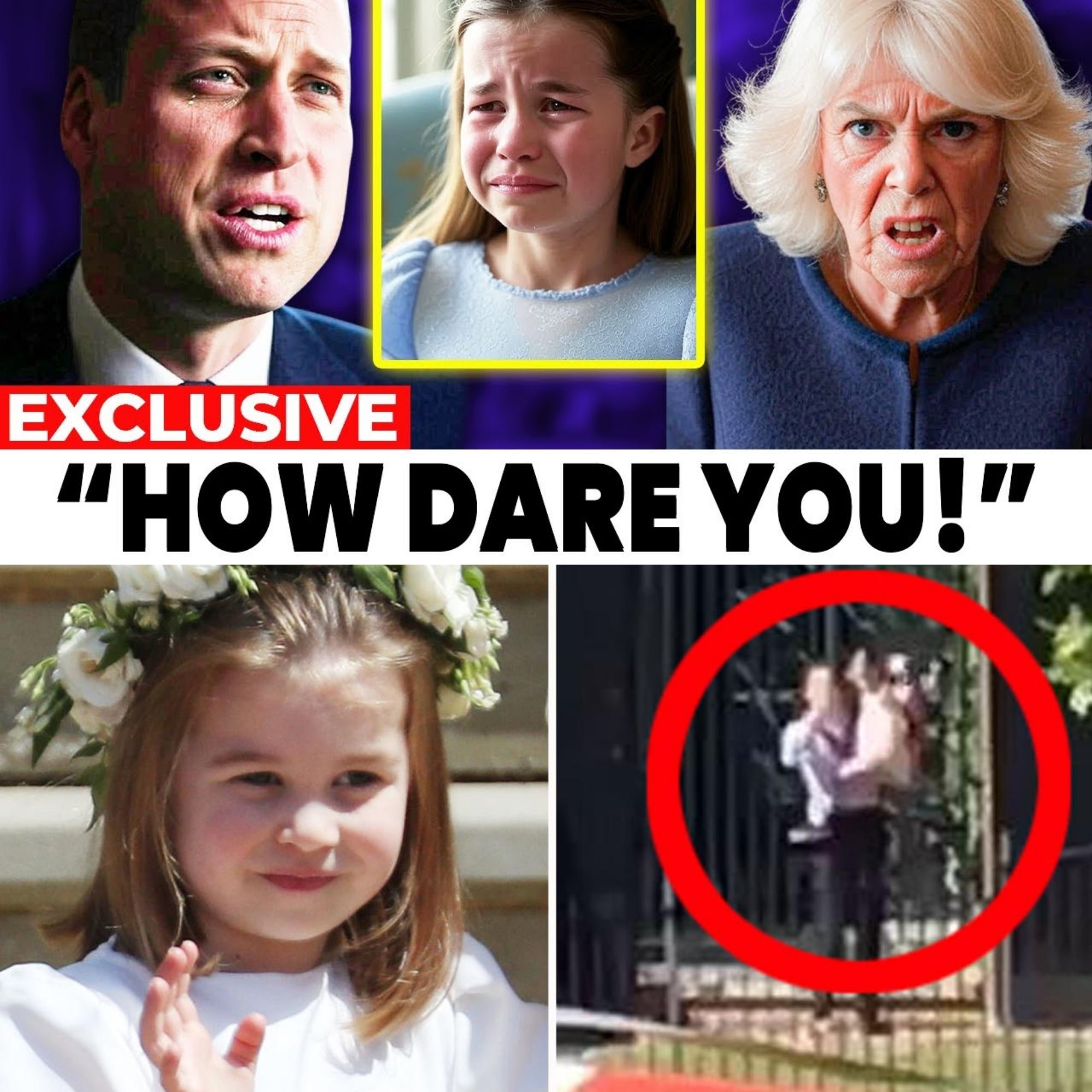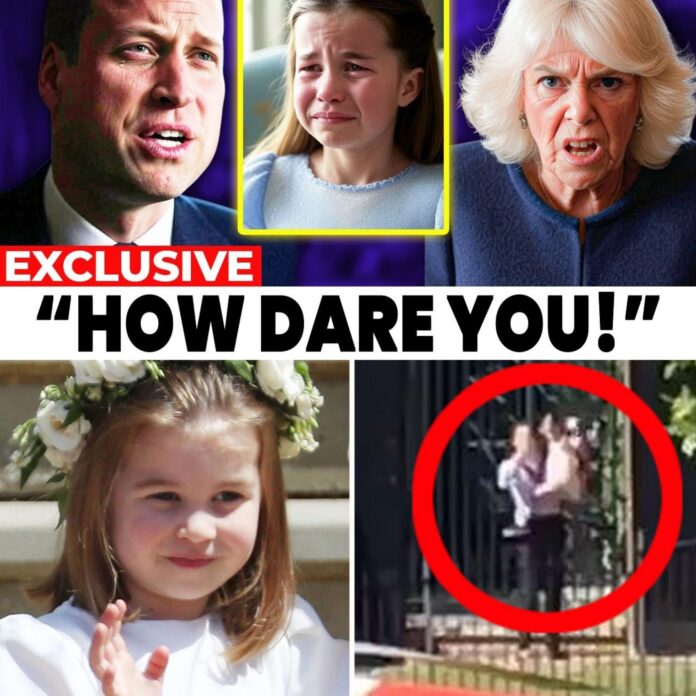🔥 ROYAL SCANDAL ALERT! Did Queen Camilla really BAN Princess Charlotte from a lavish palace ball? 😱 Prince William’s jaw-dropping 3-word response left everyone speechless… What’s brewing behind palace walls? 👑 Secrets are spilling, and you won’t believe the truth! 👀

Unraveling the Royal Rumor: Did Queen Camilla Ban Princess Charlotte from a Ball?
In the ever-churning world of royal gossip, a sensational claim has set social media ablaze: Queen Camilla allegedly banned Princess Charlotte, the young daughter of Prince William and Princess Catherine, from attending a royal ball, prompting a dramatic three-word reaction from Prince William that “shook the palace.” The story, which exploded across platforms like TikTok, YouTube, and Facebook in mid-2025, has captivated royal watchers and casual observers alike. But is there any truth to this explosive narrative, or is it just another chapter in the long history of royal rumors designed to spark intrigue? Let’s dive into the origins, context, and reality behind this viral tale, exploring the dynamics of the modern monarchy and the power of online misinformation.
The Viral Claim: A Royal Ban and a Shocking Response
The headline first gained traction through clickbait-style videos and posts, with titles screaming variations of “Queen Camilla BANNED Charlotte From a Royal Ball – Prince William’s 3-Word Reaction Shook the Palace.” These posts typically paint a vivid picture: a glamorous royal ball, a stern Queen Camilla enforcing an inexplicable ban on 10-year-old Princess Charlotte, and an enraged Prince William firing back with a cryptic phrase like “This ends now” or “How dare you.” The lack of specifics—such as the date, location, or nature of the supposed ball—only fuels curiosity, encouraging users to click for more.
The story thrives on emotional triggers: the innocence of young Charlotte, the protective instincts of a father, and the specter of a villainous step-grandmother. It taps into longstanding public perceptions of Queen Camilla, whose journey from controversial figure to consort has never fully shaken off tabloid scrutiny. Yet, as compelling as the narrative sounds, it raises immediate red flags. Why would a queen consort ban her step-granddaughter from an event? What kind of ball excludes a young royal? And why has no major news outlet reported this seismic palace drama?
Investigating the Source: A Trail of Digital Smoke
To understand this rumor, we must first trace its origins. The claim appears to have emerged from a mix of YouTube videos and social media posts in early 2025, with no verifiable primary source. One prominent YouTube channel, known for royal gossip, posted a video with dramatic narration and recycled footage of Camilla and Charlotte at unrelated events, claiming an insider “leak” but offering no evidence. Similarly, TikTok accounts have shared short clips with ominous music, urging viewers to “dig deeper” into the “palace feud.” These posts often link to dubious websites or simply loop back to more social media content, creating an echo chamber of speculation.
A fact-check by Yahoo News in July 2025 debunked a related claim—that Prince William had stripped titles from Camilla’s family or banned them from events involving his children—calling it baseless. The article noted that such stories often originate from anonymous online posts, amplified by algorithms that reward sensationalism. No credible outlet, from the BBC to The Guardian, has reported anything resembling a ban on Charlotte or a dramatic confrontation. The absence of coverage from royal correspondents, who closely monitor palace activities, suggests the story is fabricated or wildly exaggerated.
The Royal Context: Camilla, William, and Charlotte in 2025
To assess the plausibility of this rumor, let’s consider the key players and their roles in 2025. Queen Camilla, now in her late 70s, has settled into her role as consort following King Charles III’s ascension in 2022. While she has faced public criticism in the past, particularly during the 1990s, her work on literacy, domestic violence awareness, and royal duties has earned her a degree of acceptance. Public appearances show her interacting warmly with William and Catherine’s children—George, Charlotte, and Louis—at events like Trooping the Colour and state banquets. No credible reports suggest friction with Charlotte specifically.
Princess Charlotte, aged 10 in 2025, is third in line to the throne and increasingly visible in public life. She has attended high-profile events like Wimbledon, where she received a standing ovation in July 2025, and joined her parents at carefully curated royal engagements. The idea of her being “banned” from a ball seems improbable, as such events are rare for children her age, and her public role is closely managed by William and Catherine.
Prince William, as Prince of Wales, is focused on his duties, including the Earthshot Prize and mental health advocacy. Known for his measured demeanor, he has avoided public outbursts, even during periods of family tension, such as those involving Prince Harry. A “palace-shaking” three-word retort seems out of character, especially over an event with no documented existence. If such a confrontation occurred, it would likely dominate headlines from reputable sources, yet none exist.
The Role of Misinformation in Royal Narratives
This rumor fits a broader pattern of royal misinformation, where sensational stories exploit public fascination with the monarchy. The narrative of Camilla as a cruel step-grandmother echoes tabloid tropes from the 1990s, when she was cast as the “other woman” in Charles and Diana’s marriage. Modern social media amplifies these stories, using emotive language and vague details to drive engagement. The “three-word reaction” is a classic clickbait device, promising a dramatic reveal that rarely materializes.
The absence of specifics—such as the name of the ball, its purpose, or even a date—underscores the story’s lack of substance. Royal balls, like the state banquets at Buckingham Palace, are formal and infrequent, typically involving adult dignitaries, not children. A hypothetical children’s exclusion would hardly warrant a palace-shaking scandal, especially without witnesses or corroboration. The story’s reliance on recycled footage and anonymous “insiders” further erodes its credibility.
Why These Stories Persist
Royal rumors thrive because they tap into universal themes: family drama, power struggles, and the clash between tradition and modernity. The monarchy, shrouded in protocol yet endlessly scrutinized, provides fertile ground for speculation. Camilla’s complex public image makes her an easy target, while William’s role as a protective father adds emotional weight. Charlotte, as a young and beloved royal, becomes a sympathetic figure, amplifying the story’s appeal.
Social media platforms, driven by algorithms, reward content that sparks strong reactions. A post about a royal ban garners clicks, shares, and comments, even if it’s debunked later. This cycle of outrage and engagement fuels content farms, which churn out similar stories about Meghan, Harry, or other royals. The lack of immediate palace rebuttals—royals rarely comment on gossip—allows these narratives to fester.
The Bigger Picture: Navigating Royal News in the Digital Age
For royal watchers, separating fact from fiction requires skepticism and reliance on credible sources. Official channels, like the Royal Family’s website or social media, provide verified updates on engagements. Reputable journalists, such as those from The Times or Sky News, offer nuanced reporting grounded in access to palace sources. In contrast, viral posts with dramatic headlines but no substance should be approached cautiously.
The “Queen Camilla banned Charlotte” rumor also highlights broader issues of misinformation in 2025. As social media platforms evolve, so do the tactics of those seeking to exploit them. Fact-checking sites, like Snopes or Full Fact, play a crucial role in debunking false claims, but their reach often lags behind viral content. Educating audiences to question vague, unsourced stories is essential to curbing their spread.
Conclusion: A Palace Drama Without a Stage
The claim that Queen Camilla banned Princess Charlotte from a royal ball, prompting a palace-shaking reaction from Prince William, is almost certainly a fabrication. It lacks evidence, contradicts known royal dynamics, and follows a predictable pattern of clickbait-driven gossip. While the story captivates with its promise of drama, it crumbles under scrutiny, revealing more about the mechanics of online misinformation than about the monarchy itself.
For those intrigued by royal life, the real story lies in the family’s public work: Charlotte’s growing presence, William’s environmental advocacy, and Camilla’s steady role as consort. These narratives, though less sensational, offer a truer glimpse into the modern monarchy. To stay informed, skip the viral bait and turn to trusted sources. The palace may not shake, but the truth is far more compelling.
